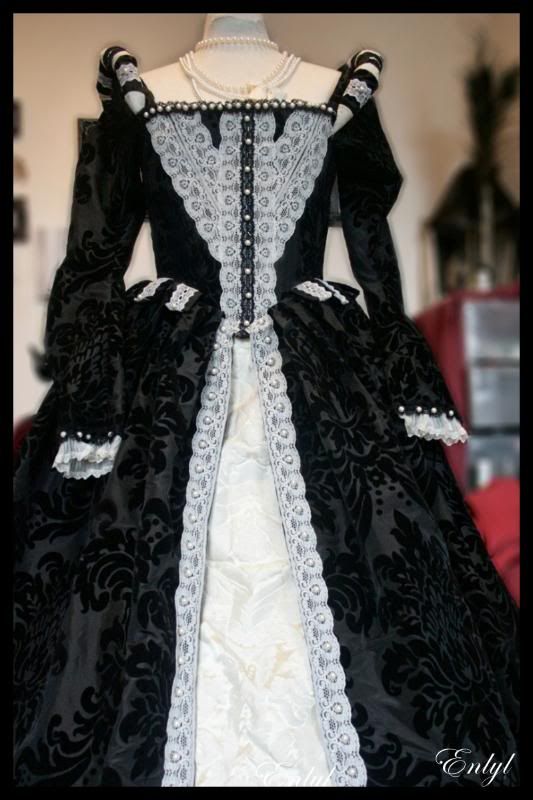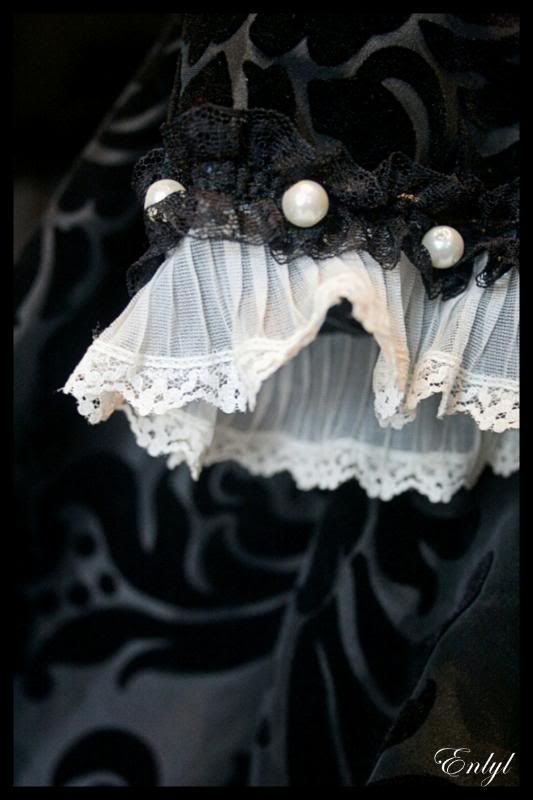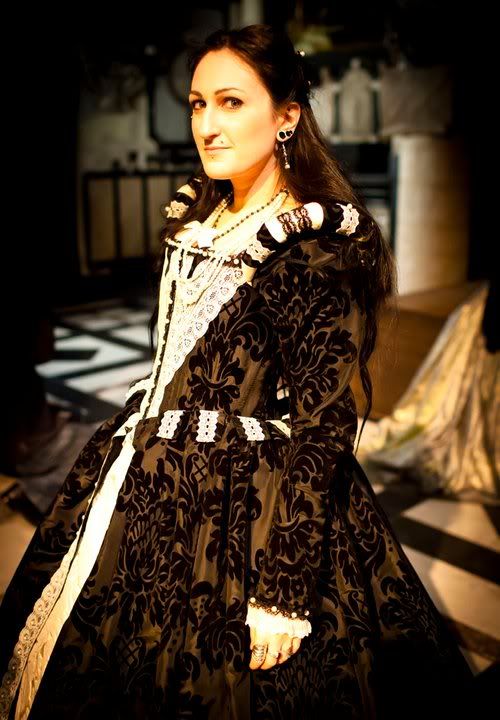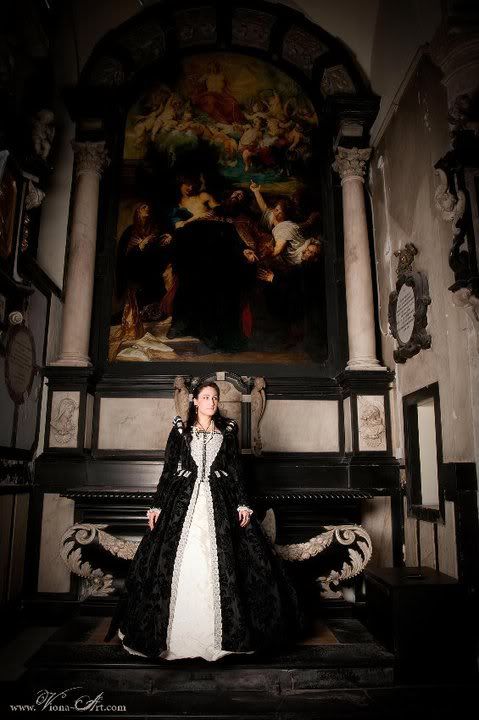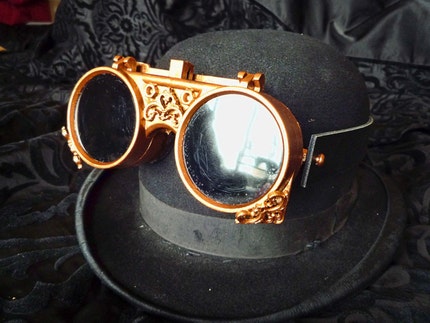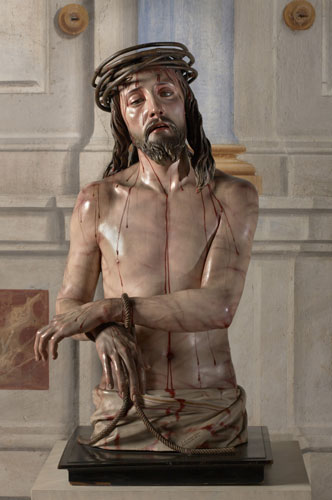A few weeks ago I attempted to sew my very first dress on time for the fantastic Gala Nocturna in Antwerp. Given the fact that I have never made a dress before or followed a pattern I honestly thought I would never be able to make it. Somehow, long hours sewing till late at night and very possibly with the help of fairies once I was asleep, the dress got miraculously finished on the nick of time :')
At the ball, photo by Soul Stealer
Photo by Viona
Saturday 19 February 2011
Tuesday 27 October 2009
St Dunstan-in-the-East
Last Sunday I went to a group photoshoot all by myself for the first time. I travelled down with my suitcase to Bank station and found a quiet street to get changed as discretely as possible. It was not easy to manoeuvre all the layers in the right order without getting half naked in public! I still don't quite know how I put on my crinoline, two skirts, a pannier, an overskirt, a lace top and finally my corset without showing too much flesh! ^-^’
The shoot took place in the medieval ruins of St Dunstan-in-the-East, a very special place in my heart and here are the very first pictures...

Picture by Deane Thomas
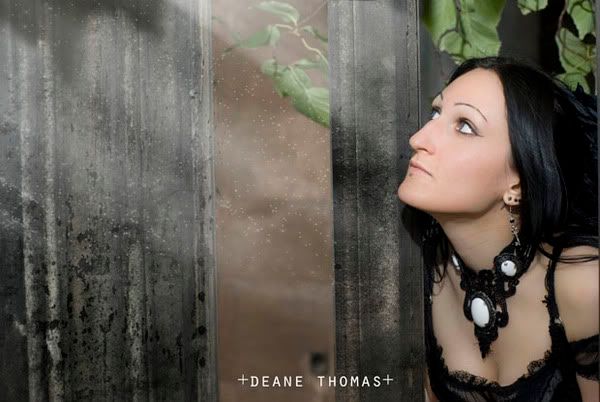
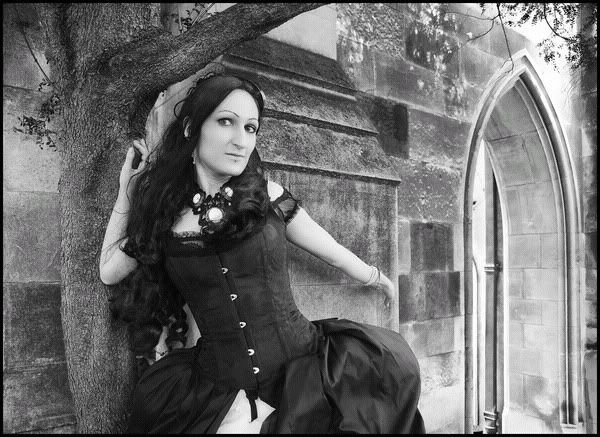
Picture by Jim Nemer
The shoot took place in the medieval ruins of St Dunstan-in-the-East, a very special place in my heart and here are the very first pictures...

Picture by Deane Thomas


Picture by Jim Nemer
Labels:
baroque,
church,
deane thomas,
enlyl,
jim nemer,
medieval,
photoshoot,
ruins,
st dunstan
Saturday 24 October 2009
Alternative Bring & Buy Sale
I just booked my stall at the next Bring & Buy Sale in December! I hope to see most of you guys there for your Christmas shopping! :D
More details here
More details here
Labels:
bring buy,
christmas,
enlyl,
enlyl's creations,
enlyl's realm,
event,
handcrafted,
handmade,
jewellery,
jewellery stall,
stall
Terraway Industries Products
One of Terraway Industries' fantastic Steampunk Sentinel Goggles has been selected Etsy's Victorian Treasury: "A lot of Victorian Nonsense"
Terraway Industries Products
One of Terraway Industries' fantastic Steampunk Sentinel Goggles has been selected Etsy's Victorian Treasury: "A lot of Victorian Nonsense"!
Friday 23 October 2009
Sacred made Real
A retrospective of some of the most realistic religious art to be produced in 17th century Spain, “The Sacred Made Real” presented at the National Gallery, is the result of 10 years of work giving art lovers the chance to see masterpieces rarely seen outside of Spain, including work by Velázquez and Zurbaran, as well as other artists involved in the Counter Reformation. Most pieces are still paraded through the streets of Spain during the Easter processions.
This is the first major exhibition to explore the relationship between sculpture and painting during the Spanish Golden Age, taking a closer look at the ways in which artists combined their skills to bring their religious subjects back to life with arrestingly real depictions designed to inspire feelings of awe and to make viewer feel the presence of Christ.
Dramatically lit against dark grey walls, the marvelous and often disturbing exhibition spares its audience nothing – gaping wounds, rivers of blood, severed heads, ruined flesh, Christ's tortures, excruciations and morbid miseries.
The first image visitors confront is the "Head of Saint John the Baptist", an impressively realistic severed head, complete with detailed rendition of the anatomy of a neck by master carver Juan de Mesa. According to Curator Xavier Bray the artist may well have used a real severed head as a model, "as a lot of people were decapitated in those days."

“Head of Saint John the Baptist”, Juan de Mesa
Sculptures from this era were painstakingly carved from wood, gessoed and intricately polychromed, many of them by Francisco Pacheco, who taught a generation of painters, including Velázquez and Cano.
Some artists used glass eyes, stained ivory for the teeth, tears made of glass and ox-horn fingernails in their work to achieve the most life like effects, reflecting a certain macabre ingenuity.
“Christ as the Man of Sorrows" (detail), Pedro de Mena, 1673
Intended to be seen from a close up, the skill with which this carving has been panting is exceptional. Blue paint has been applied beneath the flesh tones in order to suggest the bruising of Christ's skin. The rivulets of blood which trickle down his body are soaked up by the loincloth. Glass eyes have been inserted and real hair use for the eyelashes.
The sculptures were artists' response to a challenge laid down by Dominican, Carthusian and Franciscan orders who wanted to bring the sacred to life, in order to shock the senses of the faithful and strengthen their devotion.
“Dead Christ” (detail), Gregorio Fernandez, 1625-1630
Gregorio Fernandez's “Dead Christ” uses cork bark to simulate congealed blood and bull’s horn for Christ’s fingernails. His corpse has not yet been washed and prepared for burial; blood still oozes from the wonds.
“Dead Christ”, in situ, Church of Santa Maria de la Nueva,Valladolid.

"The Virgin of Sorrows" (detail), Pedro di Mena, about 1673
Painted wood, ivory, glass and human hair.
For those interested in finding out more about how the 17th century artists created their polychrome sculptures, “The Sacred Made Real” is accompanied by a free exhibition running alongside the main display.
Labels:
17th century,
art,
blood,
exhibition,
national gallery,
painting,
sacred,
sculpture,
spanish
Subscribe to:
Posts (Atom)

